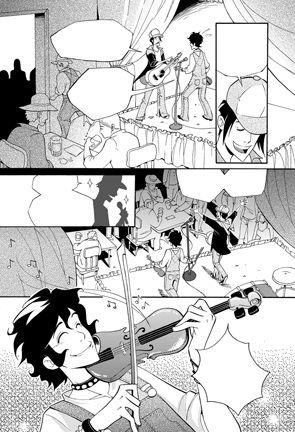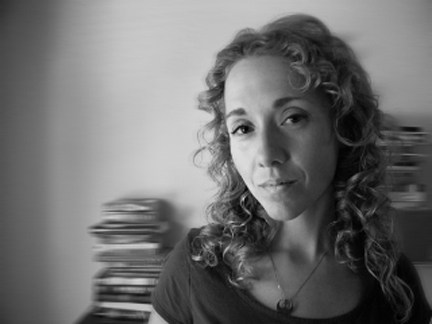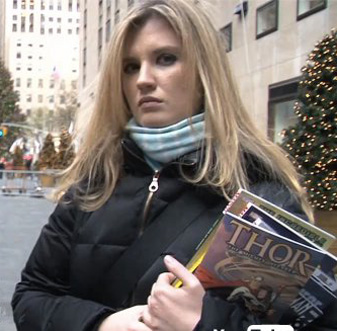Whether they admit it or not, every editor has a stable of artists and writers that they tend to work with more than others. This team of talent is unique to each editor and very rarely is it shaped entirely by the skill of the individuals on it. Usually, the creators who find themselves at the top of an editor’s personal roster possess a perfect combination of talent, dependability and personality. They’re people that the editor knows can get the job done on time with no headaches, even under the most difficult of circumstances, and produce amazing results.
Joanna Estep has long been one of those artists for me. She’s professional, dependable and one of the nicest people I’ve ever worked with. She’s also one of the most original and unique talents working in comics today. With projects that range from colorful, all-ages comics like Fraggle Rock to dark, gritty shorts aimed squarely at the over-18 set, Joanna’s portfolio is as eclectic and compelling as the artist herself.
It’s no coincidence that she’s worked on Fraggle Rock four different times!
Joanna, you’re another artist that I know through Tokyopop, but it occurred to me that I don’t really know much about your life before that. How long have you been drawing? When did you decide you wanted to draw comics?
Well, I’ve been actively drawing comics since I was in high school…toward the end of which I started to print out more of my work and distribute it at comic conventions, or try to get it published in indie anthologies. My interest in comics initially began as an interest in animation, but the more I learned about animation, the more I realized that it was actually comics that could provide the creative control I really wanted. It seemed like the ideal way for me to tell stories with art.
How did you get involved with Tokyopop? Did you have interest in manga at the time?
In taking my portfolio and my comics around with me at comic conventions, I eventually crossed paths with Mark Wheatley of Insight Studios. Mark put me in touch with writer Allan Gross, and the two of us started putting pitches together. As a reader I loved manga, but as an artist, I was indifferent to it. I didn’t feel like it was really my style. However, when Tokyopop took an interest in one of the pitches that Al and I put together, I altered my style to be more manga-esque, and to more closely resemble the sort of material that they were interested in publishing.
That series was called Roadsong and was one of the few OEL (Original English Language) projects they published that actually reached its conclusion. How do you feel about Roadsong now?
I have a lot of mixed feelings about Roadsong, actually. As my first major publication, and my first experience with a publisher, I can’t help but look back on it and wish that I had done some things differently, or been more savvy about it. But by the same token, it was those experiences that helped shape me into the artist and businessperson that I am now. As a whole, it was a very important learning experience. Roadsong really opened a lot of doors for me, and I’m proud to have seen it through to completion.
What were some of your other projects prior to Roadsong?
A lot of comics paved the way for Roadsong. Many of them were minor things I did for fun and were never intended to be published or seen outside my circle of friends. But the pre-Roadsong project that I’m most fond of would have to be my short comic “Jungle Love,” which was initially printed in the anthology “Fractured Kisses #3” and published by Strawberry Comics. It was a story told entirely in pictures and contained no dialogue, but it drew attention to my visual storytelling skills and led to more paying work. I still sell reprints of it at conventions.
One of the things that I really love about you as an artist — something that becomes instantly clear to anyone who visits your website — is that you seem capable of readily changing your style. The comics in your portfolio look pretty different from each other. Is this deliberate? Do you like pushing yourself in different directions?
It’s definitely deliberate to the point of being problematic for me. I can’t help wanting to try new styles and new media, and while I feel that this tendency helps me to grow as an artist and learn very quickly, I also worry that I’m lacking a signature style. People tell me that there are defining characteristics of my work that shine through in everything that I do, but I worry that having such a varied body of work is a poor marketing strategy in the long run. But I am what I am, and I’ve discovered that it’s usually pointless and/or harmful to fight against my own artistic tendencies.
In light of what you just said, if you could define your style, how would you?
All over the place. No, really. But whatever tools or tricks I’m using, I think that the common factor that shines through is a kind of welcoming sensuality. My love for stories is often very character-driven, so I instinctively draw my characters in a very personal way. I want them to look like someone that everyone can recognize, and to feel like someone you’d want to get to know, based solely on their appearance and what emotions you can see in their facial expressions and body language. The “acting” of my figures is the most important aspect of my style.
Much of your work has been in black and white, even though I personally think you’re a phenomenal colorist. Is there a reason for this? Do you prefer black and white comics over color ones?
As a reader, I don’t really have a preference regarding color or black and white comics. But as an artist, I’ve definitely tailored my work to look its best in black and white. I find it a welcome challenge to get the same sort of emotional response out of a black and white image as can be achieved with a colored image. However, I think that this approach has led me to view the addition of color to my own work as tedious and unnecessary.
Of the work you’ve done since Roadsong, one of the comics that really stands out to me is Happy Birthday, Michael Mitchell, which is a short standalone webcomic that you wrote and illustrated for Tor. How did that project come about?
I have to lay the blame for Happy Birthday on another friend and Tokyopop alum, C. Lijewski. Despite the fact that I’m often tapped to illustrate a lot of light-hearted work and children’s media, I have a dark streak that needs expression too. Lijewski understands that about me, and we’d discussed putting together a darkly-themed anthology, and to just let our imaginations run wild without deferring to the rules and regulations of any publisher. However, the anthology had been seeing a lot of delays, so I submitted Happy Birthday to Tor in the interim, and was able to bring it to completion for their website.

The VERY un-Fraggle-like Happy Birthday, Michael Mitchell -- a dark, Twilight Zone-like short both written and drawn by Joanna.
It’s drawn in a really gritty style that looks like something that you might see in a Vertigo crime comic. How difficult was that style for you?
It was certainly a big change for me, considering the work I’d done previously. But I’d drawn a fair amount of illustrations in a similar style, and wanted to make the jump to drawing comics in that style as well. Tor had me re-ink a lot of the pages, but I learned a lot and have since gained confidence and acclaim as a writer and illustrator of drama and horror; two genres I absolutely love.
Happy Birthday, Michael Mitchell is also one of the few comics you’ve published that you wrote yourself. As a writer, are you typically drawn to those sort of dark, twisty stories?
Most definitely. I like stories that give me chills, make me think… or ultimately rip my heart out and stomp on it. I love stories that really make me feel something, and those are the sorts of stories I want to share with others in my writing.

The opening page from "Where Have all the Doozers Gone?" -- one of two Fraggle Rock stories that Joanna illustrated for our anthology.
You’ve drawn two Fraggle Rock stories and colored a third one, making you one of the most frequent contributors to the comic. Now, I know you weren’t all that familiar with Fraggle Rock before we started. Do you consider yourself a fan now?
Don’t forget the cover illustration that I did as well! And yes, I do consider myself a fan now. It’s hard to spend so many hours drawing characters and working to bring them to life and not get a little attached. I’m glad that my introduction to the world of Fraggle Rock has been such a unique one.
Were you a fan of Jim Henson’s other work?
Oh, certainly. Specifically things like The Storyteller and The Dark Crystal…though The Muppets also charm me on an entirely different level. Jim Henson’s work has always been a big inspiration to me.

Joanna was also the first artist in our comic to bring Uncle Travelling Matt to the page in the short story "Different Tastes," which was written by Adrianne Ambrose.
This was the first brand-licensed comic book you’d worked on. Was it a challenge working with a licensor? Would you like to do more work-for-hire projects, or do you prefer to stick to projects that you create or co-create yourself?
It was a challenge, yes… but I welcome most challenges. In fact, it’s been very rewarding to work on a brand-licensed project, because I finally have something on my resume that my non-comics-reading parents can recognize, understand and brag about. It’s surprising what a relief that can be.
I’ve noticed that in addition to your comic book and illustration work, you’re also a very active blogger. Do you feel blogging helps you build awareness as an artist?
See, I’m laughing to myself right now, because I can already see that this interview is going to make me look like a serious blogger, when in reality nothing could be further from the truth. I use livejournal as a blogging client, and at first it was an ideal way to network with other comics professionals, but many artists have moved on to other clients for their “serious blogs” in recent years. I’m a big stick-in-the-mud, so I still keep my livejournal to post art, and various grievances about art. I also use it to to behave nerd-ily and to express my inner fangirl, so I end up posting as many internet memes as I do actual content. I view it as more of a personal outlet than a professional one… but I still meet and connect meaningfully with a lot of artists through my blog and that’s important to me. If I ever start a more “serious” blog with the intent of raising awareness about my work, I’ll be sure to let you know.

One of the covers from Joanna's upcoming fantasy series The Hunt, which is one of many pieces of art to initially debut in her blog.
One of the great things about your blog is that it really illustrates the ups and downs of being a freelance artist. You post new art and blog about new projects, but you also blog about your lack of health insurance, your challenges finding an agent and your frustration with the slow pace of publishing and your occasional lack of new work. It shows the exciting side of drawing comics for a living along with the totally unsexy side. Does being so open help you build a stronger relationship with your fans? Are any of your followers hopeful artists themselves?
I think that the vast majority of the folk who read my blog are hopeful artists, or are artists working in the field already. As I said, my blog has been a valuable networking tool, and helps me to feel that I don’t have “fans” so much as “friends.” I sometimes worry that my openness isn’t doing anything good for me business-wise, but I was an artist first, and it’s been my lifelong struggle to always express myself as best I can. I realize that being so open about my feelings and experiences might not make me look very cool or savvy, but it’s important to me that everyone know that I’m a person, and not just a robot who makes comics appear effortlessly out of nowhere.
So what are you working on now? What’s next for you?
Right now, I’m working on several projects, my favorite being a fantasy miniseries called The Hunt that I’m developing with writer Jared Koon. I was wary about taking on the project at first, but I can never resist a new challenge, and Jared is great to work with. He really cares about the look and feel of the stories and characters he writes, and his attention to detail gives me a lot of confidence. I feel like he’s always got my back, in that regard. Jared and I intend to distribute The Hunt digitally, and it should be available very soon.
And finally, what’s the oddest thing you’ve ever drawn? I’ve seen Carl Sagan fanart from you and have heard rumors of boys love fanart based around Star Trek and The Prestige, among others.
This has got to be my favorite question out of everything you’ve asked, since before I was a creator, I was a fan. It’s true, I make a lot of fanart and subvert a lot of canon…for fun, not profit. The strangest things I’ve ever drawn have all been on dares from other fans, I expect. It might be a tie between the time I drew Eomer from The Lord of the Rings trilogy in drag, or the time that I irreverently illustrated characters from both The Dark Tower series and the Twilight series as blood-covered vampire-spider babies playing in a sandbox together. For kicks, I even made an animated gif out of that second one. Vampire-spider babies should sparkle in real time, after all.
And yes, I’m guilty of being not just a trekkie, but one of THOSE trekkies who think Kirk and Spock are madly in love and need to get married, like, yesterday.
For more information on Joanna and her projects, be sure to visit her website: http://cargocollective.com/joannaestep.
And for some great geeky art and other such loveliness, check out her blog: http://jou.livejournal.com
We have more Fraggle Rock creator interviews on the way, so keep checking back!














